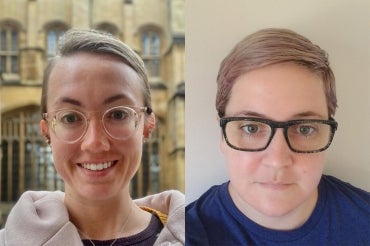English scholars develop unique resource for asexuality and aromanticism research

U of T Mississauga's Jenna McKellips, left, and Liza Blake, right, co-created the Asexuality and Aromanticism Bibliography, which currently contains more than 500 references (photos supplied)
Published: April 11, 2023
It is now easier for researchers to study asexuality and aromanticism thanks to a new resource created by two University of Toronto English scholars.
Liza Blake, an associate professor of medieval and Renaissance literature at U of T Mississauga, and Jenna McKellips, a graduate student in English language and literature, have co-created the Asexuality and Aromanticism Bibliography.
The bibliography is unique in that it combines references to literature on asexuality, which is defined as having little to no sexual attraction to others, with those on aromanticism, which is defined as not being romantically attracted to others.
While other collections of citations and references on these orientations exist, Blake and McKellips say much writing in this area is scattered across the web, which can make research difficult.
“One of the best ways we thought to advance this field of study was to let people save themselves that extra step and just dive right in and find the relevant writing for them,” says Blake, who has taught classes on early modern asexualities and is co-editing a scholarly collection on this topic.
The project arose through the two scholars’ research process while the bibliography was launched last September.
“A lot of the work academic work on aromanticism is kind of buried within asexuality resources. So we wanted to make those writings visible without conflating them,” says McKellips, whose research focuses mainly on queer virginities – and more narrowly on asexualities – in the context of medieval drama.
The bibliography currently contains more than 500 references to asexuality and aromanticism writings that are primarily humanities- and theory-based resources, although there are plans to add psychological and sociological sources touching on scientific discourses on asexuality that influence theoretical formulations. There are also reading and teaching collections that instructors can use in their courses on asexual or aromantic studies.
In addition to writings by academics, the resource includes work by members of the asexuality, or “ace,” community. The researchers say providing scholars with access to materials beyond peer-reviewed journal articles increases opportunities for truly inclusive research.
“The ace community publishes a lot of reflective and theoretical blog posts and Tumblr posts and videos on asexuality as an identity,” Blake says. “We wanted to include these as part of the archive because they are so thoughtful and meaningful.”
The bibliography was developed with the support of U of T’s Critical Digital Humanities Initiative (CDHI), an institutional strategic initiative that enables transdisciplinary collaborations that deal with questions of power, social justice and critical theory. The initiative provided McKellips with a graduate partner grant to start building the resource.
The project is an example of the type of projects that CDHI’s UX Design for DH Accelerator Program was made for, says CDHI Managing Director Danielle Taschereau Mamers, adding that the accelerator program supports researchers in creating websites, digital exhibitions, databases and other digital projects.
The CDHI Accelerator team, which included Peter Luo, a user-experience design co-op student from the Faculty of Information, and CDHI developer Matt Lefaive, worked with McKellips and Blake to identify accessibility issues on their existing site and to make it a more usable resource for both academic and wider audiences.
“In addition to implementing new design elements and improving the bibliography’s search functions, Peter tested the new design with an array of users to ensure we were meeting the research team’s goals around accessibility and usability,” Taschereau Mamers says.
To make it easy for researchers to find relevant resources, all of the bibliography’s content is tagged from a list of several dozen relevant topics. They can also filter their searches by publication type – for example, article, book chapter or dissertation, and by academic or community writing.
“One of our big goals has been to make sure that we are not thinking about categories like race and disability as secondary to asexuality. A lot of the best writing on asexuality is precisely asexuality as an intersectional category,” Blake says. “Thinking about asexuality as a critical category is something that helps us challenge what makes it difficult for asexual people to exist in the world, and how that is impacted by things like race, disability and gender.”



